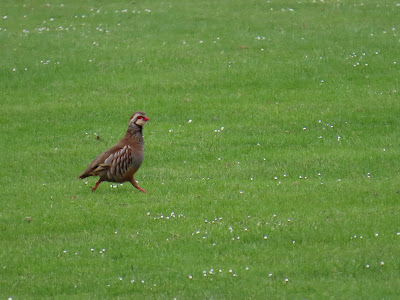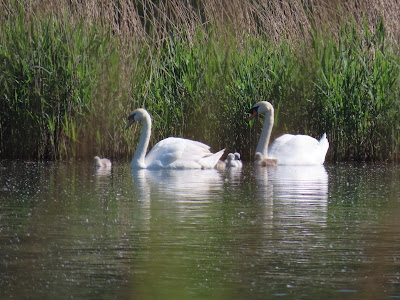Today is the last stage in the Interglacial coast trail, a circular walk, the main stretch is via the streets of Bridlington, then descending at Sewerby steps, and returning by the beach. The weather forecast threatens storms at lunch time, but fortunately there are only a couple of short, light showers and it is altogether a pleasant day, though windier in the afternoon.
I get to Bridlington station at 9:00 am, and take Bessingby road and then St Johns Avenue. I can see Bessingby Hill in front of me. In the last interglacial this stretch of the coast would have been tricky to cross, with the small Gypsey Race haven surrounded by marshes and pools. At low tide sand banks and shingle bars might have allowed passage across. There is a small stretch of the Gypsey Race visible from St John's Walk, a straight, embanked and gated stream. The final part of the stream was only daylighted recently to make the Gypsey Race park, and it has been heavily managed since historical times, with four watermills and mill ponds directing its waters to grind flour and bone, cut wood andeven produce electricity.
The remainder of the walk to Sewerby is uneventful. Swifts, Swallows flying over, Jackdaws and Herring Gulls on nests on roofs. A light shower at Sewerby, then the sun shines and I have a snack at the top of the Sewerby steps. Afterwards, I descend to the beach.
The tide has turned and is now ebbing. An Oystercatcher catches something large and a Herring Gull pursues it until I lose them from sight. A large flock of House Martins pick mud on a steep slope atop the cliff, from the glacial till. There is a population of House Martins in Flamborough that nests on the cliffs themselves, probably the ancestral nest sites for the species before they discovered houses. There is a spring at the beach, and it is a busy spot with Kittiwakes and Herring Gulls taking baths. The Kittiwakes are picking bits of seaweed and dropping them, some fly off with them, they are building or repairing their nests. Some Sandwich Terns pass by, tempted to land with the gulls, but deciding to carry on fishing.
Kittiwakes and Herring Gulls bathing and preening.
There is a lot of water seeping out of the gravels along the cliff as I walk towards Bridlington. A forest of Great Horsetails grows on the wet slopes down to the tideline. There is a little rivulet where tufa forms platforms and shallow little pools where birds often gather to bathe. Today two Greenfiches and a Whitethroat were on it. It's busy at the sea front, being Bank Holiday. I wander around the harbour for a while and then I get to the station to catch my train back.
Sewerby Palaeobeach exposure.
The Sewerby buried cliff
By the bottom of Sewerby steps is Rock Ends, where the chalk platform at the bottom of the cliffs gives way to North Sands. On the cliff itself, the chalk is replaced by glacial tills and gravels. The Sewerby paleo beach exposure is in the junction between chalk cliff and till and gravels. Unfortunately, the exposure is not very obvious today, recent rains have caused slips and much of the chalk is covered on mud. A bit of blown sand and chalk rubble is visible, but no beach shingle. Some of the raised beach formed by chalk shingle might be visible if you are lucky, higher than the current high water mark. Sands covering this paleobeach, from ancient dunes, have been dated from the Ipswichian, 120,000 years ago. This site, together with Hessle, is the only in East Yorkshire where the interglacial cliff emerges from its covering of glacial till and gravels. It is not only a geological site but an important palaeontological site.
The fossils
Fishermen had found fossils at the base of the Sewerby cliffs since the beginning of the 19th century, including the tusk of a straight-tusked elephant. After winter storms cleared the clay covering the exposure, Mortimer in 1884, alerted by Lamplugh, did some searching in the area and found bison bones. Later, Lamplugh organised an excavations with a budget of £10 of the time, in 1887. Altogether, the megafauna fauna identified from the fossils found at Sewerby, which was later revised by Boylan, is typically Ipswichian and include Cave Hyena, Bear, Straight-tusked Elephant, Narrow-nosed Rhino, Hippo, Giant Elk, and Bison.
Straight-tusked Elephant
The herd had been feeding all morning deep into the wooded pastures on the Flamborough headland, and are now marching towards the stream to drink. They follow a well-trodden track that runs roughly along where the B1255 road to Bridlington is now, avoiding the steep ravine of Danes Dyke. The matriarch, the largest and oldest elephant, distinctive for the missing tip of her right tusk, leads the way. She is sniffing the air for lions or hyenas, but doesn’t seem too anxious. The track now opens up on the valley bottom, into a grassy damp meadow, the work of the pod of hippos, which is now wallowing and snorting on the shallows of the Gypsey Race Haven.
Given the popularity of elephants, it is puzzling that the Straight-tusked Elephant, Palaeoloxodon antiquus, is so neglected compared to the other extinct European species, the Woolly Mammoth. The Straight-tusked Elephant was one of the largest terrestrial mammals to have existed, with individuals reaching over 4 m in height at the shoulder and males weighing up to 13 metric tons. It had - you guessed! - relatively straight tusks, and this was an easy way for palaeontologists to tell fossils of this species apart from the Woolly Mammoth, which had strongly curved tusks. Several molars and tusk fragments were found in excavations at Sewerby Cliff. Notably, there are little or no cave paintings that can represent Straigth-tusked Elephants, contrasting with a rich portable art and mural representations of Woolly Mammoths. A detailed reconstruction in a recent article by Larramendi and colleagues shows what the elephant might have looked like, which was reproduced as an Eofauna model depicted above.
The Straight-tusked Elephant was closely related to African Elephants and inhabited Europe in the last interglacial. The Straight-tusked elephant thrived during interglacial periods across Europe as far north as Yorkshire in the UK, and retreated to the Mediterranean during glacial periods. Both Mammoth and Straight-tusked Elephants coexisted in the transition periods between glacials and interglacials. It inhabitet deciduous woodlands or Mediterranean evergreen woodland, as opposed to the cold-adapted, open steppe or tundra of the Woolly Mammoth. The pattern of tooth wear indicates that it was a browser, rathern than a grazer. A very interesting feature of the straight-tusked elephant is its mixed ancestry: it is closely related to the extant African elephants, but it has some Woolly Mammoth ancestry and some African Forest Elephant ancestry.
Straight-tusked elephants would have lived in multi-generational matriarchal herds with young. The adult males would leave the head and join bachelor herds or become solitary, like living African elephants today. The species was hunted across Europe by several human species, during the last half million years. In the last interglacial it was regularly hunted by the Neanderthals in mainland Europe. In human-free Britain, the Straight-tusked Elephants of the last interglacial didn’t have to worry about humans, only the Cave Lion or Cave Hyenas might have posed a risk to young individuals, as evidenced by the finding of milk molars belonging to Straight tusked Elephant young in Kirkdale and Victoria caves, likely predated by hyenas.
East Yorkshire museum diorama of a herd of Straight-tusked elephants by the Flamborough Cliffs.
Can I see them?Unfortunately, Straight-tusked Elephants went extinct during the last glaciation, about 37,000 years ago, probably because the populations in the Mediterranean refugia at the height of the glaciation were small. There was little overlap with the newly arrived modern humans, but it’s possible that hunting by modern humans might have caused their ultimate demise. You can see a real fossil tusk of a Straight-tusked Elephant from Sewerby at the East Riding Museum in Hull, or you could follow the Elephant Trail along Albany Street and Spring Bank West in Hull.
Walk details. Distance: 9 km round trip. From Bridlington train station walk north along Bessingby Road and then turn right at St John's Avenue and then to Brookand Road. Take a right to High Street and continue towards Bridlington Priory Church, leave the church on your right and continue along Sewerby Road to Sewerby Village. There are refreshments and public toilets in Sewerby Hall (upon payment of £12!), several along North Beach, and at the train station. The return is descending the Sewerby Steps, and walking back along the beach, harbour, and the Gypsey Race Park to the train station.
More information
Boylan, P. J. The Pleistocene Mammalia of the Sewerby-Hessle buried cliff, East Yorkshire. Proc. Yorks. Geol. Soc. 36, 115–125 (1967).
Boylan, P. J. A new revision of the Pleistocene mammalian fauna of Kirkdale Cave, Yorkshire. Proceedings- Yorkshire Geological Society 43, 253–280 (1981).
Lamplugh, G. W. Report on the buried cliff at Sewerby, near Bridlington. Proc. Yorks. Geol. Soc. 9, 381–392 (1887).
Stuart, A. J. The extinction of woolly mammoth (Mammuthus primigenius) and straight-tusked elephant (Palaeoloxodon antiquus) in Europe. Quat. Int. 126-128, 171–177 (2005)
Larramendi, A., Palombo, M. R. & Marano, F. Reconstructing the life appearance of a Pleistocene giant: size, shape, sexual dimorphism and ontogeny of Palaeoloxodon antiquus (Proboscidea: Elephantidae) from Neumark-Nord 1 (Germany). Boll. Soc. Paleontol. Ital. doi:10.4435/BSPI.2017.29.
Moss, Cynthia (1988) Elephant Memories: Thirteen Years in the Life of an Elephant Family. Harper Collins Publisher.
Palkopoulou, E. et al. A comprehensive genomic history of extinct and living elephants. Proc. Natl. Acad. Sci. U. S. A. 115, E2566–E2574 (2018).Braun, I. M. & Palombo, M. R. Mammuthus primigenius in the cave and portable art: An overview with a short account on the elephant fossil record in Southern Europe during the last glacial. Quat. Int. 276-277, 61–76 (2012).





















































